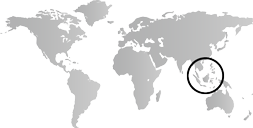In mainland Southeast Asia, courtly and urban centers flourish in prosperous regional kingdoms, such as that of Ayudhya in Thailand. Conflicting relationships between these polities often lead to changing boundaries. Development of these centers is linked in part to the growing importance of trade in the region. Theravada Buddhism flourishes in Burma and Thailand due to royal patronage and direct contact with monasteries in Sri Lanka; sculptures and paintings, often depicting the historical Buddha Shakyamuni, are produced in some number. Christianity plays an important role in the Philippines, with Chinese craftsmen producing religious images for the European and South American markets. Islam continues to flourish in island Southeast Asia and peninsular Thailand and Malaysia.
Textiles, produced in a variety of regional centers, are traded throughout the region, and to South Asia and Europe. Ceramics, produced in Vietnam and Thailand, continue to play an important role in regional transmarine commerce. The period from 1600 to 1800 is one of increasing interaction between European traders and trade goods, and the indigenous arts and cultures of the Southeast Asian archipelagos. A central force in these interactions is the Dutch East India Company, which seizes control of the lucrative spice trade from earlier Portuguese and English traders and holds a virtual monopoly on European trade in the Indonesian archipelago throughout the seventeenth and eighteenth centuries. Many Dutch trade items, such as cloth, beads, silver, and gold, are incorporated into the archipelago’s indigenous art forms. Images of Dutch ships and coats of arms also begin to appear in Indonesian wood carving and textiles.


